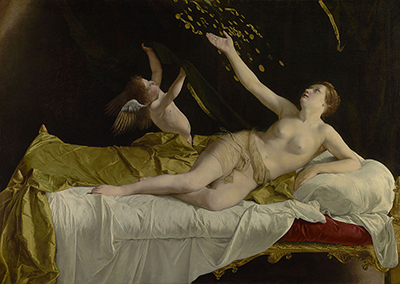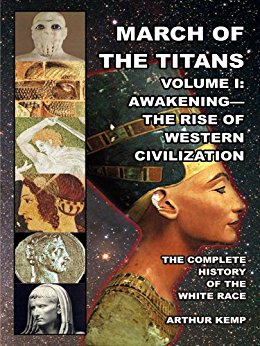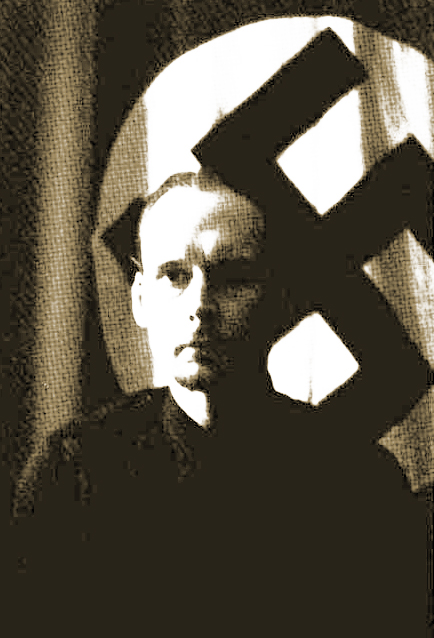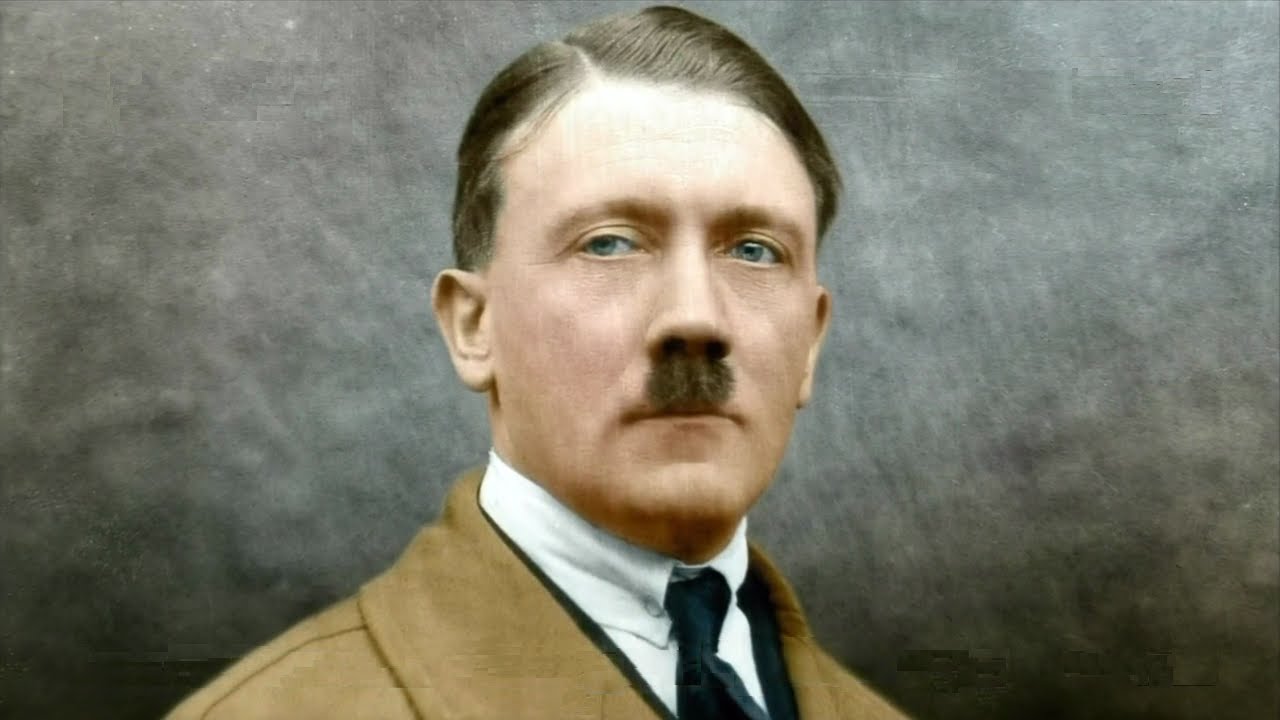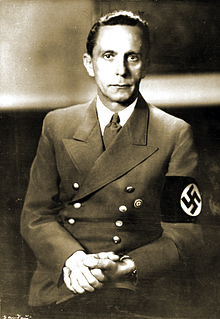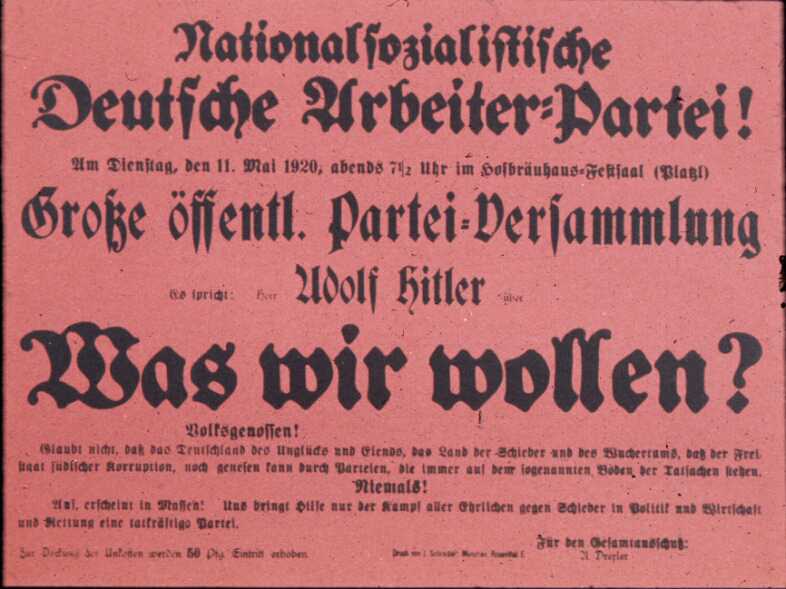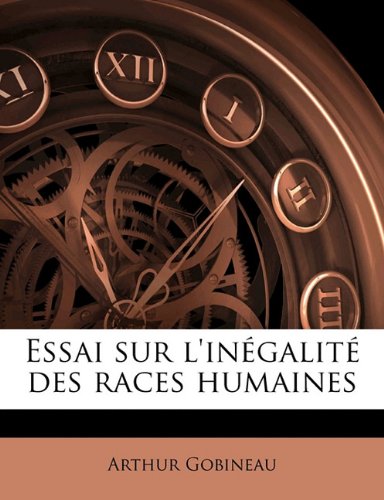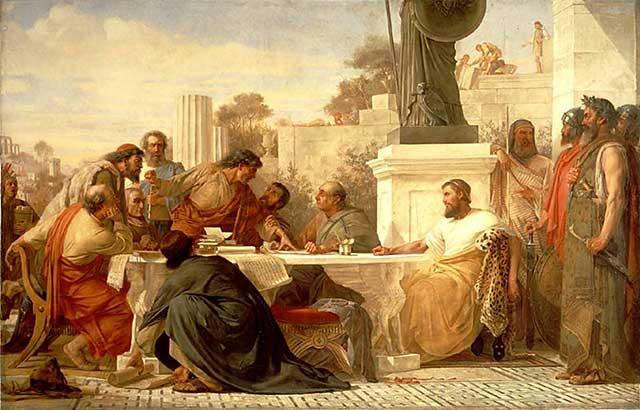by Mike Maloney
Chapter Three:
Old Glory
I hope by now you’re beginning to see a pattern develop. In all the examples I’ve shown you so far (and there are plenty more), the pattern is the same:
- A sovereign state starts out with good money (i.e., money that is gold or silver, or backed fully by gold and silver).
- As it develops economically and socially, it begins to take on more and more economic burdens, adding layer upon layer of public works and social programs.
- As its economic affluence grows so does its political influence, and it increases expenditures to fund a massive military.
- Eventually it puts its military to use, and expenditures explode.
- To fund the war, the costliest of mankind’s endeavors, it steals the wealth of its people by replacing their money with currency that can be created in unlimited quantities. It does this either at the outbreak of the war (as in the case of World War I), during the war or wars (as in the cases of Athens and Rome), or as a perceived solution to the economic ravages of previous wars (as in the case of John Law’s France).
- Finally, the wealth transfer caused by expansion of the currency supply is felt by the population as severe consumer price inflation, triggering a loss of faith in the currency.
- An en masse movement out of the currency into precious metals and other tangible assets takes place, the currency collapses, and massive wealth is transferred to those who had enough foresight to accumulate gold and silver early on.
But surely something like this can’t happen to the United States, you might say. We are, after all, the greatest country in the history of the world. Beyond that we aren’t an empire. We don’t conquer nations; we spread democracy.
We may not be an empire in the traditional sense of the word, but when it comes to economic issues, we operate like one in many ways. This is why I believe that not only will the United States decline and see its dollar crash; it’s already on its way. Let’s take a trip down memory lane and see how the United States got to this point in history.
Dread the Fed, the Golden Rule is dead
The beginning of the end for the United States economy started with the inception of the Federal Reserve. The Fed, as it’s called, is a private bank, separate from the U.S. government, with the power to dictate our country’s fiscal policy. Since the Fed’s formation, the U.S. dollar has become nothing but currency.
From roughly 1871 to 1914, when World War I began, most of the developed world operated under what is referred to as the classical gold standard, meaning most of the world’s currencies were pegged to gold. This meant that they were also pegged to each other. Businesspeople could make plans and projections far into the future, ship goods, start businesses, and invest in foreign lands, and they always knew exactly what the exchange rate would be.
On average over the period when the developed world was on the classical gold standard, there was no inflation… none, zero zip, nada. Sure, there were a few booms and busts, inflations and deflations. But from the beginning of the classical gold standard to the end, it averaged out as a zero sum game. The reason? Gold: the great equalizer.
Here’s why: When countries experienced economic booms, they imported more goods. The imported goods were paid for with gold, so gold flowed out. As gold flowed out of the countries, their currency supplies contracted (that is monetary deflation). This caused these economies to slow down and the demand for imports to fall. As the economy slowed, prices fell, making these countries’ goods more attractive to foreign buyers. And as exports rose to meet foreign demand, gold flowed back into that country. Then the process started all over again, the value of currency—based on gold—always moving up and down, in a narrow range, maintaining the equilibrium.
During the classical gold standard our currency was real, verifiable money, meaning that there was actual gold and silver in the Treasury backing it up. The currency was just a receipt for the money. Then, in stepped the Fed, one of the most notorious and misunderstood institutions in the history of the United States.
The difficulty with the Fed is that there’s a lot of information out there, which is one reason why it’s so controversial. There are two very polarized camps when it comes to the Fed. On one end you have the government, which trusts it to regulate the U.S. economy. On the other end, you have the conspiracy theorists, who believe, in no uncertain terms, that the Fed will eventually bring about the collapse of the U.S. economy.
Well, I’m here to tell you these “crackpots” are not as crazy as they may seem. For one thing, the Federal Reserve is not a government agency. It is a privately owned bank that has stockholders to whom it pays dividends. It has the power to actually create currency from nothing, and it is shielded from audits and congressional oversight. As former senator and presidential contender Barry Goldwater pointed out, “The accounts of the Federal Reserve System have never been audited. It operates outside the control of Congress and manipulates the credit of the United States.”
Not so humble beginnings
Famed Austrian School economist Murray N. Rothbard, the vice president of the Ludwig von Mises Institute, distinguished professor of economics, and author of twenty-six books, opens his book The Case Against the Fed with the following:
By far the most secret and least accountable operation of the federal government is not, as one might expect, the CIA, DIA, or some other super-secret intelligence agency. The CIA and other intelligence operations are under control of Congress. They are accountable: a Congressional committee supervises these operations, controls their budgets, and is informed of their covert activities.
The Federal Reserve, however, is accountable to no one; it has no budget; it is subject to no audit; and no Congressional committee knows of, or can truly supervise, its operations. The Federal Reserve, virtually in total control of the nation’s monetary system, is accountable to nobody.
Here’s how it all got started. You might call this the not so humble beginning.
In 1907 there was a banking and stock market panic in the U.S., aptly called the Panic of 1907. It was widely believed that the big New York banks known as the Money Trust had been causing crashes, and then capitalizing on them by buying up stocks from rattled investors and selling them for tremendous profit just days or weeks later. The Panic of 1907 was a particularly devastating one for the U.S. economy, and there was an outcry by the general public for the government to do something.
In 1908 Congress created the National Monetary Commission to research the situation, and to recommend banking reforms that would prevent such panics, as well as to investigate the Money Trust. Senator Nelson Aldrich was appointed chairman, and immediately set out for Europe, spending two years and $300,000 (that’s $6 million adjusted for inflation) to consult with the private central bankers of England, France, and Germany.
Upon his return, Senator Aldrich decided to take some time off and organized a duck hunt with some friends. The friends he invited on vacation with him were the who’s who of U.S. economic power, the very New York bankers he was supposed to be investigating: Paul Warburg (Kuhn, Loeb & Company), Abraham Pete Andrew (assistant secretary of the treasury), Frank Vanderlip (president of the Rockefeller-lead National City Bank of New York), Henry P. Davison (senior partner at J. P. Morgan), Charles D. Norton (president of the Morgan-led First National Bank of New York), and Benjamin Strong (head of J. P. Morgan Bankers Trust, and to become the first Federal Reserve head).
It is estimated that these men represented one quarter of the world’s wealth. The retreat took place on a little island off the coast of Georgia called Jekyll Island. But there wasn’t much duck hunting; instead Aldrich and his distinguished guests spent nine days around a table hatching a plan that eventually created the Federal Reserve.
Here is what some of the attendees had to say about that meeting:
Picture a party of the nation’s greatest bankers stealing out of New York on a private railroad car under cover of darkness, stealthily hieing hundreds of miles South, embarking on a mysterious launch, sneaking on to an island deserted by all but a few servants, living there a full week under such rigid secrecy that the names of not one of them was once mentioned lest the servants learn the identity and disclose to the world this strangest, most secret expedition in the history of American finance.
I am not romancing. I am giving to the world, for the first time, the real story of how the famous Aldrich currency report, the foundation of our new currency system, was written.
B. C. Forbes, Forbes magazine, 1916
The results of the conference were entirely confidential. Even the fact there had been a meeting was not permitted to become public. Though eighteen years have since gone by, I do not feel free to give a description of this most interesting conference concerning which Senator Aldrich pledged all participants to secrecy.
Paul Warburg, The Federal Reserve System: Its Origin and Growth
There was an occasion, near the close of 1910, when I was as secretive, indeed, as furtive, as any conspirator. I do not feel it is any exaggeration to speak of our secret expedition to Jekyll Island as the occasion of the actual conception of what eventually became the Federal Reserve System. We were told to leave our last names behind us… We were instructed to come one at a time and as unobtrusively as possible to the railroad terminal on the New Jersey littoral of the Hudson, where Senator Aldrich’s private car would be in readiness… The servants and train crew may have known the identities of one or two of us, but they did not know all, and it was the names of all printed together that would have made our mysterious journey significant in Washington, in Wall Street, even in London. Discovery, we knew, simply must not happen, or else all our time and effort would be wasted. If it were to be exposed publicly that our particular group had got together and written a banking bill, that bill would have no chance whatever of passage by Congress.
Frank Vanderlip, in The Saturday Evening Post, February 9, 1935
Secrecy was so important to the attendees of this summit because Aldrich, as the chairman of the National Monetary Commission, was charged with investigating banking practices and recommending reforms after the Panic of 1907, not to conspire with the bankers on a remote island. So the bankers who were under investigation for needed reforms got together with the chairman of the congressional investigating committee (the guy that was supposed to investigate the suspects) at a secret meeting on an isolated island and concocted a bill, the Aldrich Plan, for a private central bank that they (the suspects) would own. When the bill was presented to Congress, the debates raged.
In one debate, Congressman Charles Lindbergh was quoted as saying, “Our financial system is a false one and a huge burden on the people. I have alleged that there is a Money Trust. The Aldrich Plan is a scheme plainly in the interest of the Trust. Why does the Money Trust press so hard for the Aldrich Plan now, before the people know what the Money Trust has been doing?”
But the Aldrich Plan never came to a vote in Congress, because it was a Republican-backed bill and the Republicans lost control of the House in 1910, and the Senate in 1912.
Not accepting defeat, the bankers essentially took the Aldrich Plan and changed a few details. In 1913 a nearly identical bill, called the Federal Reserve Act, was presented to Congress.
Again the debates raged. Many saw this bill for what it was: a prettied-up version of the Aldrich Plan. But on December 22, 1913, Congress gave up its right to coin money and regulate the value thereof, which was given it by the Constitution, and passed that right to a private corporation, the Federal Reserve.
The Fed and the death of the dollar—fractional reserve banking
Since the Fed opened for business in 1914, the currency of the United States (the U.S. dollar) has been borrowed into existence from a private bank (the Fed). The reason I say “borrowed” into existence is because every single dollar the Fed has ever created is owed back to that bank, with interest. The Fed creates all currency, not the U.S. government, and lends it out to the U.S. government and private institutions—with interest. Now you may be asking yourself, “If we pay back all the currency that was borrowed into existence, but we still owe the interest, where do we get the currency to pay the interest?” Answer: We have to borrow it into existence. This is one reason why the national debt keeps expanding. It can never be paid off. It is mathematically impossible.
But even more disconcerting is the way the Federal Reserve creates currency:
- It makes loans to the government or banking system by writing a bad check.
- It buys something with a bad check.
In the Fed’s own words, published in a 1977 paper called Putting It Simply, “When you or I write a check there must be sufficient funds in our account to cover the check, but when the Federal Reserve writes a check there is no bank deposit on which that check is drawn. When the Federal Reserve writes a check, it is creating money” Of course, as you know by now, I would beg to differ. They are creating currency, not money.
And once those newly created dollars are deposited in the banks, the banks get to employ the miracle of fractional reserve banking.
Here is fractional reserve banking in a nutshell. All banks have a reserve requirement, meaning they must keep a certain amount of currency on hand for withdrawals and such. If the reserve requirement set by the Fed is 10 percent the bank must keep 10 percent of the currency deposited on hand just in case someone wants to make a withdrawal; however, they are allowed to loan out the other 90 percent of those deposits.
Here’s the kicker. They don’t actually loan out the currency that’s in the accounts. Instead they create new fiat dollars out of nothing and then loan them out, which means they too are “borrowed” into existence. In other words, when you deposit $1,000, the bank can create 900 brand-new credit dollars with nothing but a book entry, and then loan them out with interest.
Then, if those brand-new loaned dollars are deposited in a checking account, the bank is allowed to create another 90 percent of the value of those deposits, and then another 90 percent of that. Then the process is repeated, and round and round it goes.
Coincidentally, the same year that the Federal Reserve Act was passed, there was also an amendment added to the Constitution: the Sixteenth, which created the dreaded income tax.
Before 1913 there was no income tax. The entire government was paid for by tariffs (duties on imports) and excise tax (taxes on things like alcohol, cigarettes, and gas). These taxes, and only these taxes, generated enough income for the government to operate. However, because it didn’t generate enough income to pay the interest due to the Federal Reserve, the income tax was created.
To review:
- Since 1914, we’ve borrowed every dollar into existence.
- We pay interest on every dollar in existence.
- That interest is paid to a private bank, the Federal Reserve.
- The world’s largest banks, not the government, own the Federal Reserve.
- The United States can’t pay off its debt… it can only borrow more to pay the interest.
- Our government created income tax so we can pay this interest.
Welcome to the rabbit hole. Welcome to your new context.
